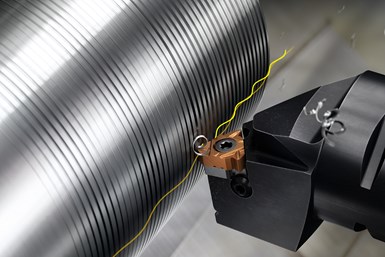Avoid Chip Jams, Downtime With Tool Path Software
Sandvik Coromant’s CoroPlus Tool Path software offers programming support for external and internal thread turning operations. The software generates NC codes based on cutting data parameters to secure the correct number of passes with evenly distributed cutting forces.
Share





Sandvik Coromant’s OptiThreading software module for thread turning helps overcome the risk of chip jams and associated downtime. Photo Credit: Sandvik Coromant
Sandvik Coromant has unveiled a new machining method that enables controlled chip breaking in thread turning applications. Launched within the existing CoroPlus Tool Path software, OptiThreading is a new software module that the company says will help manufacturers avoid the risk of chip jams and associated downtime.
CoroPlus Tool Path software offers programming support for external and internal thread turning operations. The software generates NC codes based on cutting data parameters to secure the correct number of passes with evenly distributed cutting forces, which is said to optimize productivity, tool life and process security.
According the company, a common problem in thread turning is that chips coil around robots, chucks, tools and components. The chips can get caught in conveyors, causing damage and equipment downtime. OptiThreading has been designed with these challenges in mind, and the module is available as part of a subscription to the CoroPlus Tool Path, and is developed specifically for CoroThread 266 tools and inserts.
Using the method and software, manufacturers can fully optimize their thread turning operations. As part of the solution, CoroPlus Tool Path helps users develop optimized OptiThreading tool paths that specifically overcome the challenge of chip control. This is achieved by offering tool paths that deliver controlled, oscillating movements for interrupted cuts that go in and out of the cut on all passes except the last one.
Sandvik Coromant says supporting this cutting method delivers multiple benefits. Using OptiThreading eliminates long chips that damage a component’s surface and interfere with the cutting zone, improving component quality. It also results in less manual work to remove long chips jamming the tool, the component or the chip conveyor, resulting in fewer unplanned machine stops. OptiThreading also makes it possible to increase cutting speeds for shorter cycle times and improved productivity.
OptiThreading creates high cutting forces and therefore needs a tool that can withstand them. The CoroThread 266 has an iLock interface that offers exceptional stability for insert indexing, making it capable of handling extreme forces. The tool is also available in a wide variety of assortments, with a selection of grades and geometries that cover most materials and applications. Together, the software and hardware solutions are said to deliver secure, precise threading that is not hampered by poor chip control.

























.jpg;maxWidth=970;quality=90)